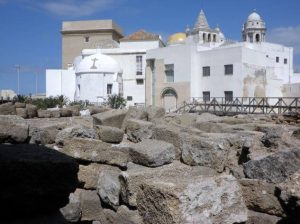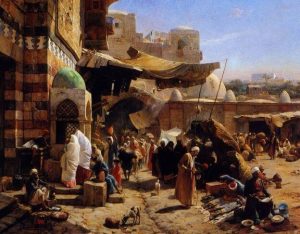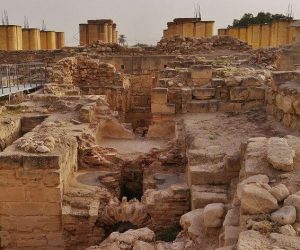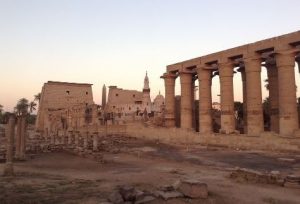What were the oldest cities and civilizations in the ancient world?
The development of agriculture and livestock farming allowed human beings to settle and live more permanently on fixed land. So it was goodbye to nomadism, and hello to sedentism. Since then, cities have been an essential part of our world, although not always the most important. Their existence throughout history is also proof of the stubbornness and resistance of human beings: there are times where, when we have chosen to make a place our home, we have never abandoned it, and ended up spending thousands of years there.

This is what has happened to some of the oldest cities known to man. Cities whose existence, in the same place they are found today, can be traced back millennia, witnesses of man’s evolution throughout the centuries. They are living museums and relics of the past which, unlike others (Babylon or Angkor in memoriam) have survived over time, and are still important social and economic hubs today. We have chosen 21 of the world’s oldest cities and compared how they were with how they are today.
Note: all the dates are archaeological estimations and interpretations, and refer to the origins of the settlements, not to their definitions as a “city” per se. Generally, it is not known which is the oldest permanently habited city. By defect, those of the Fertile Crescent are the most notable. From there many dates have been obtained.
Ancient Civilizations Cities: The Oldest Cities in the World
Contents
- Ancient Civilizations Cities: The Oldest Cities in the World
- Beijing, China (1000 BC)
- Cadiz, Spain (~1100 AC)
- Lisbon, Portugal, (-1200 BC)
- Chania, Greece (1700 BC)
- Varanasi, India (1800 BC)
- Kutaisi, Georgia (2000 BC)
- Damascus, Syria (2000 BC)
- Kirkuk, Iraq (2200 BC)
- Erbil, Iraq (2300 BC)
- Jaffa, Israel (~2000 BC)
- Plovdiv, Bulgaria (~ 2000 AC)
- Rey, Iran (3000 BC)
- Jericho, Palestine (3000 BC)
- Beirut, Lebanon (3000 AC)
- Luxor, Egypt (3200 BC)
- Jerusalem, Israel (~ 3000 BC)
- Athens, Greece (~ 4000 BC)
- Aleppo, Syria (~ 4000 BC)
- Argos, Greece (~ 5000 BC)
- Byblos, Lebanon (~ 5000 BC)
Beijing, China (1000 BC)
There are different theories about the origin of Beijing as an urban settlement. It is known that around 10,000 BC there were settlements of some sort in Ancient China, but they were not big enough to be officially called a city. The Chinese government considers the year 1045 BC to be the official year of the birth of today’s Eastern capital. It is, in all likelihood, the oldest city in East Asia.
To date, the Chinese capital is one of the largest cities on the planet, and one of the major economic and financial centers of East Asia. Beijing has grown so much it has become shaped by its demographic expansion and by the architectural rigors of Chinese communism, in a radical transformation that, nevertheless, is coherent with its traditional position of relevance and power in the region.
Cadiz, Spain (~1100 AC)

Founded by the Phoenicians around 1100 BC, Cadiz is, by all means, the oldest urban settlement in Spain, and perhaps the whole of the Iberian Peninsula (competing only with Lisbon, as we will see below) and one of the most ancient in all Western Europe. Named Gadir in its early days by its Phoenician founders, Gades later on, and finally Cadiz, the city has been a permanent mixture of cultures in a small islet in the Atlantic. Cadiz was used as a trading port of entry for Phoenician and Greek colonies.
Currently, Cadiz is the capital of the province, named after the city, and forms an important piece of the history of modern Spain, due to being the home of the Constitution of 1812.
Lisbon, Portugal, (-1200 BC)
Settlements in Lisbon have been registered before 1200 BC, but there was no urban development worthy of such name until the Phoenicians arrived and created a trading port.
This city has many similarities with Cadiz´s development and competes with Cadiz as being Europe’s most historical Western city.
Despite the destruction Lisbon suffered in the 18th century due to a devastating earthquake, it has a mix of cultures and many notable architectural ruins.
Today, Lisbon is the capital of Portugal and has suffered dramatic modifications in its urban appearance due to the fire in the 18th Century, which completely demolished the city center.
Only the neighborhood of Alfama was saved, in the historic center, and the rest was redesigned as the city expanded.
Chania, Greece (1700 BC)
The origins of Chania as an urban settlement go back to one of the ancient Greek civilizations, the Mycenaean, long before the classical splendor of the end of the Bronze Age.
However, it wouldn’t acquire the ranking of city (despite its abstract and questionable nature) precisely until the end of the Bronze Age and the arrival of the Doric invasions, which would ultimately lead to the collapse of the Mycenaean culture. This is mentioned in Homer’s Odyssey.
Today, Chania is one of many Greek seaside towns that mainly depend on tourism. It also has a rich history due to being part of Crete: there are ruins dating back to the Byzantine Empire, the trading and military powers of Venice and, of course, the extremely long lasting Ottoman Empire.
Varanasi, India (1800 BC)
Mark Twain, in his routine imaginative squandering, named Varanasi the oldest city in the world, even older than places that were already established.

However, this is not entirely true: the city, impressively located around the river Ganges, could undoubtedly be titled the oldest city in India, but it is far from being one of the first and longest-lasting urban settlements of the planet.
These days, Varanasi is a modernized big city and very significant within the Indian state of Uttar Pradesh. Famous for its many monuments on the banks of the river Ganges, which can be accessed by varied and very iconic staircases, Varanasi is also a key component for industry (especially textile) in the region.
Kutaisi, Georgia (2000 BC)
It may be surprising that this city appears on the list. However, the Caucasus has seen the progress of some of the most important civilizations far from the Middle East in history, perhaps precisely due to its proximity to the Fertile Crescent. Kutaisi is considered to be the first capital of the early Kingdom of Georgia, before the Colchis, and fixed urban settlements in the same place as today’s city have been known of since thousands of years ago.
Kutaisi maintains much of its old architectural legacy, although the city has been greatly reformed and transformed since its inception, which is understandable. Despite everything, it has several Human Heritage Monuments, such as Bagrati Cathedral, depicted in the image and built in the early 11th century. Kutaisi would later become the capital of the first Kingdom of Georgia.
Damascus, Syria (2000 BC)
Damascus is occasionally given the pompous title of “oldest city in the world”. The temptation is great and logical too: there are archaeological records of settlements in the area dating back to 9000 BC, which, in effect, would make it an ancient and unique urban record. However, the historical reality is a little more stubborn: it has been agreed that the “city” status of the Syrian capital would be limited to the year 2000 BC, which was approximately when the Arameans came to the area and turned the hamlets into one city.

Today; Damascus is not the biggest city in Syria, but it is its capital. Almost entirely controlled by forces loyal to Al-Assad, Damascus has been afflicted during the past five years by the bloody civil war that is slowly breaking Syria apart. Not as damaged as Homs or Aleppo, Damascus also has suffered the consequences of fighting and bombings, and today faces days of uncertainty within a war that seems impossible to solve in the short term.
Kirkuk, Iraq (2200 BC)
Today a city which has little photographic record on the Internet, located halfway between the Arabic and Kurdish sides of Iraq, Kirkuk, just like the ancient Arrapha, has existed in the Middle East for more than four thousand years. Arrapha was Sumerian, Babylonian and Assyrian. It later ended up buried under the relentless weight of history, but in exchange Kirkuk emerged.
If there is one word that defines Kirkuk today, it is war. Since 2003, the city has been besieged by many bloody conflicts. The invasion of Iraq ended with the construction of a U.S. base and the continued presence of U.S. troops in the surrounding area. Subsequently captured by the Islamic State after its emergence in 2014 and recovered by the Kurdish Peshmerga troops in the subsequent months, Kirkuk today tries to survive the unstable and mined environment that surrounds it.
Erbil, Iraq (2300 BC)
There is evidence of settlements in the current Erbil dating back to 5000 BC, but the existence of a city as such is not commonly accepted until approximately 2300 BC. What used to be the ancient city of Arbela, Erbil today is Kurdistan’s main city. According to UNESCO, the Citadel has more than 8,000 years of continuous human habitation.
Today Erbil is part of the Iraqi state, but it is commonly considered the cultural and political capital of the Iraqi Kurds, and the most important city in the whole of Kurdistan. With around 1,000,000 inhabitants, Erbil has an immense architectural heritage (the Citadel, in the center of the image, is perhaps its most significant historical complex) and a turbulent life, halfway between the final autonomy of Iraqi Kurdistan and the constant fight against external threats, such as the Islamic State.
Jaffa, Israel (~2000 BC)

A similar case to the ones above. We still don’t know exactly when the settlements around Jaffa, which today is encompassed within the metropolitan giant of Tel Aviv, became a proper urban structure, but it is thought that it was around 2000 BC. The archaeological remains show that human beings continually inhabited the zone up to five thousand years before, developing the ancient Hebrew civilization.
Today Jaffa has lost its independent city status and is located within the municipal district of Tel Aviv, Israel’s large coastal city. With stunning ancient relics, Jaffa has a beautiful port and an intricate historic center. About 54,000 people live in the city.
Plovdiv, Bulgaria (~ 2000 AC)
Another strange case within Europe, just like Georgia: according to some sources, Plovdiv can be considered the oldest city in the world. It is true that there is evidence of settlements dating back to as early as 6000 BC, but more precise sources tend to place its foundation around 4000 BC. Incidentally, its foundation is Thracian, an Indo-European tribe that inhabited the present lands of Bulgaria (and many others from Eastern Europe) before losing their language and culture at the hands of Greeks and Romans.
Today Plovdiv is one of the largest cities in Bulgaria, with more than 300,000 inhabitants. Like many others, it entered a severe and continuing decline in the years following the end of communism, but it has recovered part of its lost pulse after Bulgaria’s entry into the European Union.
Rey, Iran (3000 BC)
Formerly known as Arsacia, Rey is perhaps Iran’s oldest city, but today has been engulfed by the spectacular growth of Tehran, the capital city of the country. Excavations during the 20th century have revealed that this city of great architectural richness has been inhabited as early as 3000 BC. It would have been one of the most important cities of the Parthian Empire.
Today Rey is a city that, like Jaffa, has been buried under the growth of another even bigger city, which in this case is Tehran, the megalopolis that serves as capital for the current state of Iran. It has an important heritage, thanks to its vast history, and numerous archaeological sites.
Jericho, Palestine (3000 BC)
Jericho is anther one of the cities which tends to assume the title of the oldest in the world. It is certain that the existence of Jericho as a city can be traced up to 3000 BC or earlier, but not to 9000 AC which, similar to the case of Damascus, is needed in order to give such a title. The Jericho area has been inhabited since the dawn of humanity and boasts the oldest military fortifications in the world (prior to 6000 BC), but in no way was it considered a “city” until several millennia later.

With a turbulent history beyond the biblical mythology (the Jews returned here after their liberation from slavery in Egypt, led by Moses), Jericho today is a picturesque city at the edge of the Dead Sea*. It was part of the Ottoman Empire for over 400 years. Later it became part of the British Empire, which was given to the British Mandate of Palestine. It is part of Israel, 27 kilometers from Jerusalem, but it belonged to Jordan until 1967, when it was seized after the Six Day War by the Israeli State.
Beirut, Lebanon (3000 AC)
The city that refuses to die, as defined by The Guardian, has already accumulated more than five millennia of existence behind it, and the story continues. The excavations in its interior have revealed traces of urban life initiated around 3000 AC.
To this day, Beirut is a vibrant city, but also under constant threat of war conflict and terrorism. The streets are distributed in a heterogeneous way; Christians, Shiite Muslims, and Sunni Muslims creating an ecosystem that is unique throughout the entire Middle East. It is the capital of Lebanon, with around two million inhabitants.
Luxor, Egypt (3200 BC)
Originating from the ancient Egyptian Thebes, today known as Luxor, it is known as one of the most important capitals of the Egyptian Empire, on the banks of the Nile, and can be considered a city since approximately 3200 BC. Today its antiquity draws inexhaustible tourists to the city, thanks to the magnificent and still very well preserved ruins of this great civilization.

Today mainly dedicated to tourism and agriculture, Luxor, before called Thebes, is the largest city in the south of Egypt. With around 400,000 inhabitants, the ruins and archaeological remnants are two essential pillars of its economy, but the passing of time has meant that its inhabitants must live in more ordinary and contemporary buildings, adapted to the needs of a modern city that has never stopped growing, looking back at the ancient splendor of Thebes.
Jerusalem, Israel (~ 3000 BC)
A city among cities, few are as mystical and relevant in the history of so many cultures, as Jerusalem. Its origins lie halfway between mythology and reality, but it is known that there have been urban settlements (vibrant and magnificent) as early as 3000 BC. It was destroyed by the Babylonians and little remains today of its wonders (such as the Temple of Solomon). For millennia, it has been the object of desire of many powers, which is reflected in its archaeological and architectural variation.
Jerusalem today, several millennia later, continues to be an inexhaustible source of religious conflicts. With Israel on one side and Palestine on the other, the city largely belongs to the first. With a population of around one million, it is not the largest city in the region but it is the most symbolic, the most troubled, and the city that holds within it some of the most significant monuments in the whole Jordan Valley.
Athens, Greece (~ 4000 BC)
Human presence in Athens, the current Greek capital, goes back to several millennia before Christ, but its foundation as a city is a little more modest. Several sources indicate that it was constituted as an urban settlement around 4000 BC, making it the current capital of the world’s oldest continent. Like other Greek cities, this commendable fact corresponds to the Mycenae.
Athens today is the capital of Greece, and little remains of its previous splendor and position of superiority in the Mediterranean. On the contrary, it is going through difficult times, and is involved in a huge economic crisis, which dragged the country and the city to permanent gridlock. Densely populated, it is one of the largest cities in the European continent, and also one of the liveliest.
Aleppo, Syria (~ 4000 BC)
Damascus is not the oldest city in the Middle East. It is not even the oldest in Syria. Such honor can be awarded to the now highly degraded and destroyed Aleppo, victim of incessant bombing from the bloody Civil War that has plagued the country since 2011. It is currently living the darkest chapter in its long history, which finds its urban origins in 4000 BC.

7,000 years later, Aleppo went through one of the most delicate moments of its long and ample history. The city has served as stage for some of the fiercest battles of the Syrian Civil War, causing the partial destruction of most of the city. Reduced to ruins, Aleppo today is a ghost town where the only way out for its millions of inhabitants, five years after the conflict began, is to flee.
Argos, Greece (~ 5000 BC)
Europe’s most ancient urban settlement is Argos, in the peninsula of the Peloponnese. Halfway between Europe (nicknamed the Old Continent) and the Middle East, in Argos there are traces of human life dating back to over nine thousand years ago, and it is perhaps the first city worthy of the title. It is a remarkable fact, although today it is only reason why this primitive city appears in this ranking: Argos is a small city, and irrelevant, even inside Greece.
Currently, Argos is a small settlement in the peninsula of the Peloponnese, with little political or economic significance. What it does have is numerous archaeological settlements that bear witness to its ancient character.
Byblos, Lebanon (~ 5000 BC)
At this point, the reader is reminded that all dates included in this article are estimations. And few estimations seem so consistent as those made about Byblos, in Lebanon, which position the city in 5000 AC and beyond, making it possibly the most ancient city of the world that still inhabited today. Essential in the understanding of the origins and the development of the Phoenician culture, Byblos is a World Heritage Site.
Today, Byblos is a beautiful city with around 40,000 inhabitants, with a metropolitan area that exceeds 100,000.
